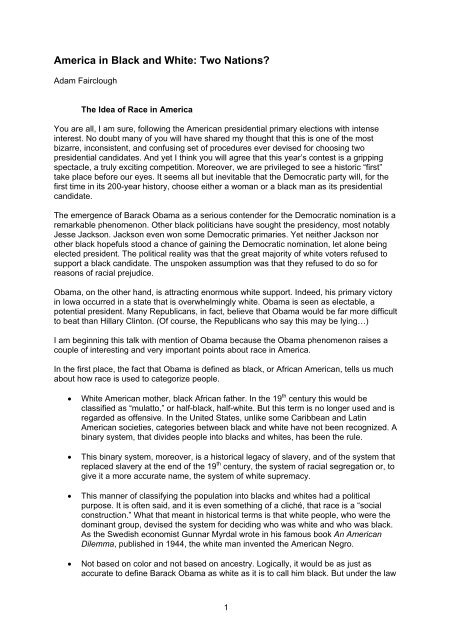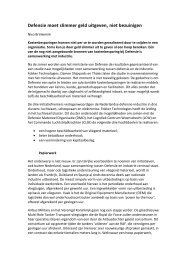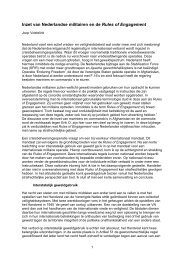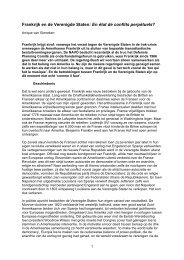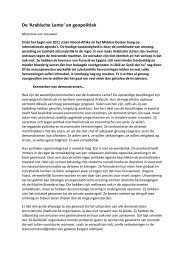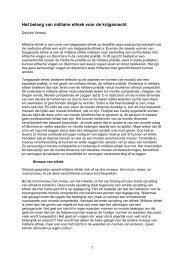The idea of race in America
The idea of race in America
The idea of race in America
You also want an ePaper? Increase the reach of your titles
YUMPU automatically turns print PDFs into web optimized ePapers that Google loves.
<strong>America</strong> <strong>in</strong> Black and White: Two Nations?Adam Fairclough<strong>The</strong> Idea <strong>of</strong> Race <strong>in</strong> <strong>America</strong>You are all, I am sure, follow<strong>in</strong>g the <strong>America</strong>n presidential primary elections with <strong>in</strong>tense<strong>in</strong>terest. No doubt many <strong>of</strong> you will have shared my thought that this is one <strong>of</strong> the mostbizarre, <strong>in</strong>consistent, and confus<strong>in</strong>g set <strong>of</strong> procedures ever devised for choos<strong>in</strong>g twopresidential candidates. And yet I th<strong>in</strong>k you will agree that this year’s contest is a gripp<strong>in</strong>gspectacle, a truly excit<strong>in</strong>g competition. Moreover, we are privileged to see a historic “first”take place before our eyes. It seems all but <strong>in</strong>evitable that the Democratic party will, for thefirst time <strong>in</strong> its 200-year history, choose either a woman or a black man as its presidentialcandidate.<strong>The</strong> emergence <strong>of</strong> Barack Obama as a serious contender for the Democratic nom<strong>in</strong>ation is aremarkable phenomenon. Other black politicians have sought the presidency, most notablyJesse Jackson. Jackson even won some Democratic primaries. Yet neither Jackson norother black hopefuls stood a chance <strong>of</strong> ga<strong>in</strong><strong>in</strong>g the Democratic nom<strong>in</strong>ation, let alone be<strong>in</strong>gelected president. <strong>The</strong> political reality was that the great majority <strong>of</strong> white voters refused tosupport a black candidate. <strong>The</strong> unspoken assumption was that they refused to do so forreasons <strong>of</strong> racial prejudice.Obama, on the other hand, is attract<strong>in</strong>g enormous white support. Indeed, his primary victory<strong>in</strong> Iowa occurred <strong>in</strong> a state that is overwhelm<strong>in</strong>gly white. Obama is seen as electable, apotential president. Many Republicans, <strong>in</strong> fact, believe that Obama would be far more difficultto beat than Hillary Cl<strong>in</strong>ton. (Of course, the Republicans who say this may be ly<strong>in</strong>g…)I am beg<strong>in</strong>n<strong>in</strong>g this talk with mention <strong>of</strong> Obama because the Obama phenomenon raises acouple <strong>of</strong> <strong>in</strong>terest<strong>in</strong>g and very important po<strong>in</strong>ts about <strong>race</strong> <strong>in</strong> <strong>America</strong>.In the first place, the fact that Obama is def<strong>in</strong>ed as black, or African <strong>America</strong>n, tells us muchabout how <strong>race</strong> is used to categorize people.• White <strong>America</strong>n mother, black African father. In the 19 th century this would beclassified as “mulatto,” or half-black, half-white. But this term is no longer used and isregarded as <strong>of</strong>fensive. In the United States, unlike some Caribbean and Lat<strong>in</strong><strong>America</strong>n societies, categories between black and white have not been recognized. Ab<strong>in</strong>ary system, that divides people <strong>in</strong>to blacks and whites, has been the rule.• This b<strong>in</strong>ary system, moreover, is a historical legacy <strong>of</strong> slavery, and <strong>of</strong> the system thatreplaced slavery at the end <strong>of</strong> the 19 th century, the system <strong>of</strong> racial segregation or, togive it a more accurate name, the system <strong>of</strong> white supremacy.• This manner <strong>of</strong> classify<strong>in</strong>g the population <strong>in</strong>to blacks and whites had a politicalpurpose. It is <strong>of</strong>ten said, and it is even someth<strong>in</strong>g <strong>of</strong> a cliché, that <strong>race</strong> is a “socialconstruction.” What that meant <strong>in</strong> historical terms is that white people, who were thedom<strong>in</strong>ant group, devised the system for decid<strong>in</strong>g who was white and who was black.As the Swedish economist Gunnar Myrdal wrote <strong>in</strong> his famous book An <strong>America</strong>nDilemma, published <strong>in</strong> 1944, the white man <strong>in</strong>vented the <strong>America</strong>n Negro.• Not based on color and not based on ancestry. Logically, it would be as just asaccurate to def<strong>in</strong>e Barack Obama as white as it is to call him black. But under the law1
<strong>of</strong> slavery a child always took the legal status <strong>of</strong> its mother. <strong>The</strong> purpose <strong>of</strong> this lawwas clear: to permit white men to father children by slave women without weaken<strong>in</strong>gthe system <strong>of</strong> slavery. <strong>The</strong> child <strong>of</strong> a white father and a slave mother wasautomatically slave.• After the abolition <strong>of</strong> slavery, as whites struggled to impose a subord<strong>in</strong>ate and <strong>in</strong>feriorstatus upon the newly-freed black population, they had to devise a new legaldef<strong>in</strong>ition <strong>of</strong> black and white. So they passed laws def<strong>in</strong><strong>in</strong>g you as a black person ifyou had more than a small fraction <strong>of</strong> so-called “black blood.” This meant thatalthough you might look white, if you had one great-great-great grandparent who wasblack, you could not take the legal status <strong>of</strong> a white person. <strong>The</strong> laws <strong>of</strong> some statesdecreed that “any t<strong>race</strong>able” colored or Negro ancestry def<strong>in</strong>ed you as black.• <strong>The</strong> consequences <strong>of</strong> be<strong>in</strong>g def<strong>in</strong>ed as black were <strong>of</strong> course enormous. You attendedseparate schools, sat at the back <strong>of</strong> the bus, couldn’t vote or hold political <strong>of</strong>fice, andwere excluded from all the best jobs. You were systematically degraded, <strong>in</strong>sulted,demeaned, and subject to the violence <strong>of</strong> lynch mobs.• To buttress this system every southern state, and some northern states too, passedlaws that made it a crime for blacks and whites to marry, to cohabit, or to have sexualrelations.Now all this might seem very remote from today. <strong>The</strong> civil rights movement <strong>of</strong> the 1950s and1960s destroyed this system <strong>of</strong> white supremacy. Racial discrim<strong>in</strong>ation is illegal. Blacks canvote and hold <strong>of</strong>fice. And for the past forty years, s<strong>in</strong>ce the Supreme Court held thatVirg<strong>in</strong>ia’s law aga<strong>in</strong>st racial <strong>in</strong>termarriage was unconstitutional, blacks and whites have beenfree to marry.<strong>The</strong> US census now allows people to choose which racial category they th<strong>in</strong>k best describesthem, and it has recently added “mixed <strong>race</strong>” as one <strong>of</strong> the possible choices. Yet thepresumption that you are either black or white persists. As a boy Obama struggled with hisown identity, but came to def<strong>in</strong>e himself as black. And although he tries to avoid be<strong>in</strong>g limitedpolitically by his racial identity, he knows that his potential appeal to African <strong>America</strong>n votersis an enormous political advantage.Obama, then, represents the convergence <strong>of</strong> the old and the new <strong>in</strong> <strong>race</strong> relations. Hecannot escape the pull <strong>of</strong> the old black-white division, but he is try<strong>in</strong>g to transcend it.Andrew Hacker and the “Two Nations” ConceptTo any European travell<strong>in</strong>g to the United States, two facts about <strong>race</strong> are immediately visible.One is the extent to which black and white <strong>America</strong>ns live <strong>in</strong> geographically dist<strong>in</strong>ct areas,the segregation <strong>of</strong> cities and suburbs by <strong>race</strong>. <strong>The</strong> second is the scale <strong>of</strong> extreme poverty,and the fact that such poverty is concentrated among black <strong>America</strong>ns. <strong>The</strong>se strik<strong>in</strong>gconditions, which are easy to observe just about anywhere <strong>in</strong> the United States, encouragethe easy conclusion that <strong>America</strong> is still a society characterized by fundamental <strong>in</strong>equalitiesbetween blacks and whites. It also prompts the obvious question: To what extent are suchpersist<strong>in</strong>g <strong>in</strong>equalities the products <strong>of</strong> racism?Andrew Hacker, Two Nations: Black and White, Separate, Hostile, Unequal (1992).Unexpected bestseller. Punchy, readable prose buttressed by copious statistics. Basic thesisthat it is still an enormous advantage to be born white, and an equally large disadvantage tobe born black. In terms <strong>of</strong> <strong>in</strong>come, wealth, education, health, hous<strong>in</strong>g, political <strong>in</strong>fluence, andfreedom from violent crime, whites as a group are far better <strong>of</strong>f than blacks as a group. And amajor explanation for that difference, accord<strong>in</strong>g to Hacker, is the cont<strong>in</strong>u<strong>in</strong>g impact <strong>of</strong> racism.2
Hacker def<strong>in</strong>es racism <strong>in</strong> three ways:• Attitudes and actions <strong>of</strong> <strong>in</strong>dividuals that have adverse effect upon blacks. He cites theexample <strong>of</strong> a taxi driver who refuses to stop for black riders – one <strong>of</strong> the mostcommon forms <strong>of</strong> discrim<strong>in</strong>ation experienced by blacks. <strong>The</strong> taxi driver may simply beprejudiced, or he may be mak<strong>in</strong>g a rational calculation that he is more likely to berobbed if he picks up a black rider. But the effect is the same, and the action,regardless <strong>of</strong> motivation, is unfair.• Institutional racism. <strong>The</strong> powerful <strong>in</strong>stitutions <strong>of</strong> <strong>America</strong>n society – banks, bus<strong>in</strong>esscorporations, law firms, universities etc. – have an <strong>in</strong>herent bias aga<strong>in</strong>st blacksbecause <strong>of</strong> their overwhelm<strong>in</strong>gly white make-up. That bias may not be <strong>in</strong>tentional, butit nevertheless works aga<strong>in</strong>st blacks. Blacks are the outsiders try<strong>in</strong>g to get <strong>in</strong>. <strong>The</strong><strong>in</strong>siders, who have the right social connections and are familiar with the rules, have abuilt-<strong>in</strong> advantage.• <strong>The</strong> stigma <strong>of</strong> slavery. “<strong>The</strong>re persists the belief that members <strong>of</strong> the black <strong>race</strong>represent an <strong>in</strong>ferior stra<strong>in</strong> <strong>of</strong> the human species.” Racism developed as ajustification for the enslavement <strong>of</strong> Africans, and then, after the abolition <strong>of</strong> slavery,for the system <strong>of</strong> racial segregation or white supremacy. In the late 19 th and early 20 thcenturies, scholars gave scientific respectability to the <strong>idea</strong> that darker sk<strong>in</strong>nedpeoples were <strong>in</strong>herently <strong>in</strong>ferior to lighter-sk<strong>in</strong>ned peoples. By the 1950s suchth<strong>in</strong>k<strong>in</strong>g was largely discredited, and today hardly any scholars openly express abelief that blacks are <strong>in</strong>ferior. Yet Hacker argues that most white <strong>America</strong>ns, partlybecause they harbor negative images <strong>of</strong> Africa, cont<strong>in</strong>ue to suspect that people <strong>of</strong>African ancestry are less advanced than members <strong>of</strong> other <strong>race</strong>s.<strong>The</strong>se three variants <strong>of</strong> racism, Hacker concludes, make for a powerful and toxiccomb<strong>in</strong>ation. And they expla<strong>in</strong> why the black-white division is still the most importantdeterm<strong>in</strong>ant <strong>of</strong> one’s life chances <strong>in</strong> <strong>America</strong>.Some contend that the massive scale <strong>of</strong> immigration by non-white peoples <strong>in</strong> recent decadeshas rendered the <strong>idea</strong> <strong>of</strong> “two nations” out-<strong>of</strong>-date.• In 1970 whites made up 83 % <strong>of</strong> US population; blacks 11%. Hispanics provided only4,5% and Asians a mere 1%.• By 2000 Hispanics had become the biggest m<strong>in</strong>ority group, with 12% <strong>of</strong> thepopulation. <strong>The</strong> proportion <strong>of</strong> Asians now constituted 3,6%.Surely, then, the old biracial division <strong>of</strong> black and white has been superseded by a multiracialsociety, with at least four major racial categories.Wrong, says Hacker. Neither “Asian” nor “Hispanic” constitute racial groups. In the first place,the various peoples with<strong>in</strong> those two categories have no common history, no commonidentity, and identify themselves primarily by their national orig<strong>in</strong> – they regard themselves asJapanese, Korean, Cuban, Dom<strong>in</strong>ican and so forth.In the second place, members <strong>of</strong> these other groups are not subject to the samediscrim<strong>in</strong>ation that black <strong>America</strong>ns suffer. This is partly a matter <strong>of</strong> history. Althoughmembers <strong>of</strong> both groups experienced discrim<strong>in</strong>ation, neither Asian-<strong>America</strong>ns nor Hispanic-<strong>America</strong>ns have ever been slaves on <strong>America</strong>n soil, avoid<strong>in</strong>g the endur<strong>in</strong>g stigma thatslavery impressed upon its victims. Asian-<strong>America</strong>ns and Hispanic-<strong>America</strong>ns f<strong>in</strong>d it mucheasier to “become white” <strong>in</strong> the sense <strong>of</strong> be<strong>in</strong>g accepted by, and assimilated to, the white3
majority population. Most Asian-<strong>America</strong>ns, for example, marry outside their own group. Inaddition, few whites object to the presence <strong>of</strong> Asian <strong>America</strong>ns <strong>in</strong> their neighborhoods, orobject to Asian-<strong>America</strong>n children attend<strong>in</strong>g their schools. Most Hispanic-<strong>America</strong>ns eitherregard themselves as already white, or decl<strong>in</strong>e to make any racial choice. Before 1970, <strong>in</strong>fact, the US census automatically classified them as “white.”<strong>The</strong> conclusion that Hacker draws is that the deepest and most relevant racial division is stillthe one between blacks and other <strong>America</strong>ns, and that it is susta<strong>in</strong>ed by racism.<strong>The</strong> “End <strong>of</strong> Racism” <strong>The</strong>sis1. Accord<strong>in</strong>g to <strong>America</strong>n conservatives, on the other hand, Hacker’s analysis is wrong onevery po<strong>in</strong>t – wrong <strong>in</strong> its fundamental argument and wrong <strong>in</strong> its presentation <strong>of</strong>evidence. I label the conservative position the “end <strong>of</strong> racism” thesis, and I choose as itsbest example a book by Stephan and Abigail <strong>The</strong>rnstrom, <strong>America</strong> <strong>in</strong> Black and White:One Nation, Indivisible (1999).• Direct rebuttal <strong>of</strong> Hacker’s “two nations” thesis. White racial prejudice is no longer amajor barrier to black advancement.• Election <strong>of</strong> blacks <strong>in</strong> white-majority districts• Ris<strong>in</strong>g <strong>in</strong>comes <strong>of</strong> blacks with education (e.g. women with university degrees)• No ceil<strong>in</strong>g to black advancement (Clarence Thomas, Condoleezza Rice, OprahW<strong>in</strong>frey)• Decl<strong>in</strong>e <strong>in</strong> racist attitudes as measured <strong>in</strong> op<strong>in</strong>ion polls2. Disparities are not conclusive evidence <strong>of</strong> racial discrim<strong>in</strong>ation• Different racial/ethnic groups carve out occupational niches• Paucity <strong>of</strong> black elected <strong>of</strong>ficials is due to concentration <strong>of</strong> blacks <strong>in</strong> the liberal w<strong>in</strong>g <strong>of</strong>the Democratic Party at a time <strong>of</strong> Republican dom<strong>in</strong>ance3. Black poverty ma<strong>in</strong>ly is caused by cultural deficiencies• High proportion <strong>of</strong> s<strong>in</strong>gle-parent families• Lack <strong>of</strong> commitment to education• Drug use, crim<strong>in</strong>al behavior4. Civil rights agenda <strong>of</strong> the 1960s is obsolete• Integrated schools are no panacea• Tactics <strong>of</strong> protest are <strong>in</strong>appropriate and counterproductive• Free markets, not government <strong>in</strong>tervention, is the solution<strong>The</strong>se <strong>idea</strong>s are endorsed by black conservatives such as Clarence Thomas and ThomasSowell.Conservative Political Climate S<strong>in</strong>ce 1980No doubt there is someth<strong>in</strong>g to be said for both Hacker’s position and that <strong>of</strong> the<strong>The</strong>rnstroms; both seem to be extreme <strong>in</strong>terpretations. <strong>The</strong> problem with Hacker is that hisevidence is <strong>of</strong>ten anecdotal and his op<strong>in</strong>ions subjective. <strong>The</strong> problems with the <strong>The</strong>rnstromsis that they are so committed to prov<strong>in</strong>g their thesis that they distort statistical evidence.4
<strong>The</strong> evidence <strong>of</strong> substantial black progress s<strong>in</strong>ce the civil rights movement is overwhelm<strong>in</strong>g.Consider that before 1960:• Most blacks <strong>in</strong> the South could not vote• <strong>The</strong>re were virtually no black elected <strong>of</strong>ficials <strong>in</strong> the South• Blacks were systematically excluded from entire sectors <strong>of</strong> the employment market(<strong>in</strong> 1960 a black person <strong>in</strong> the South could not even get a job driv<strong>in</strong>g a bus).• <strong>The</strong>re were few black policemen, no black sheriffs or police chiefs.• <strong>The</strong> crim<strong>in</strong>al justice system (judges, prosecutors) was all-white• Segregation laws excluded blacks from cafes, restaurants, hotels, parks, playgrounds• Blacks had separate and <strong>in</strong>ferior schools and hospitals• Blacks were systematically disrespected by white people (never addressed by theirsurname; made to sit at the back <strong>of</strong> the bus).Yet there is also no doubt that the political climate s<strong>in</strong>ce 1980 has adversely affected blacks<strong>in</strong> important ways. Progress for some has been accompanied by retrogression for others.1. Harsh crim<strong>in</strong>al justice policies• “War on Drugs” has led to harsh mandatory sentences• “Three strikes and you’re out” laws• popularity <strong>of</strong> the death penalty• disfranchisement <strong>of</strong> convicted felons2 million people are now <strong>in</strong> <strong>America</strong>’s jails – the highest prison population <strong>in</strong> the world <strong>in</strong> bothabsolute and relative numbers. Almost half <strong>of</strong> these prisoners are African <strong>America</strong>ns.2. <strong>The</strong> Supreme Court is no longer encourag<strong>in</strong>g school <strong>in</strong>tegration: we see the end <strong>of</strong> theBrown-era that began <strong>in</strong> 1954.• Segregated schools result<strong>in</strong>g from segregated hous<strong>in</strong>g patterns are not illegal.Hous<strong>in</strong>g segregation is a consequence <strong>of</strong> <strong>in</strong>dividual private decisions, notgovernment action• Even voluntary desegregation plans are illegal if based upon us<strong>in</strong>g <strong>race</strong> as a means<strong>of</strong> assign<strong>in</strong>g children to different schools• <strong>The</strong> most segregated school systems are to be found <strong>in</strong> northern states like NewYork and California• Public schools <strong>in</strong> the South are re-segregat<strong>in</strong>g.3. It is now illegal to deliberately create black-majority electoral districts. (Shaw v. Reno1994)Adam Fairclough is pr<strong>of</strong>essor <strong>of</strong> <strong>America</strong>n Studies at Leiden University5


